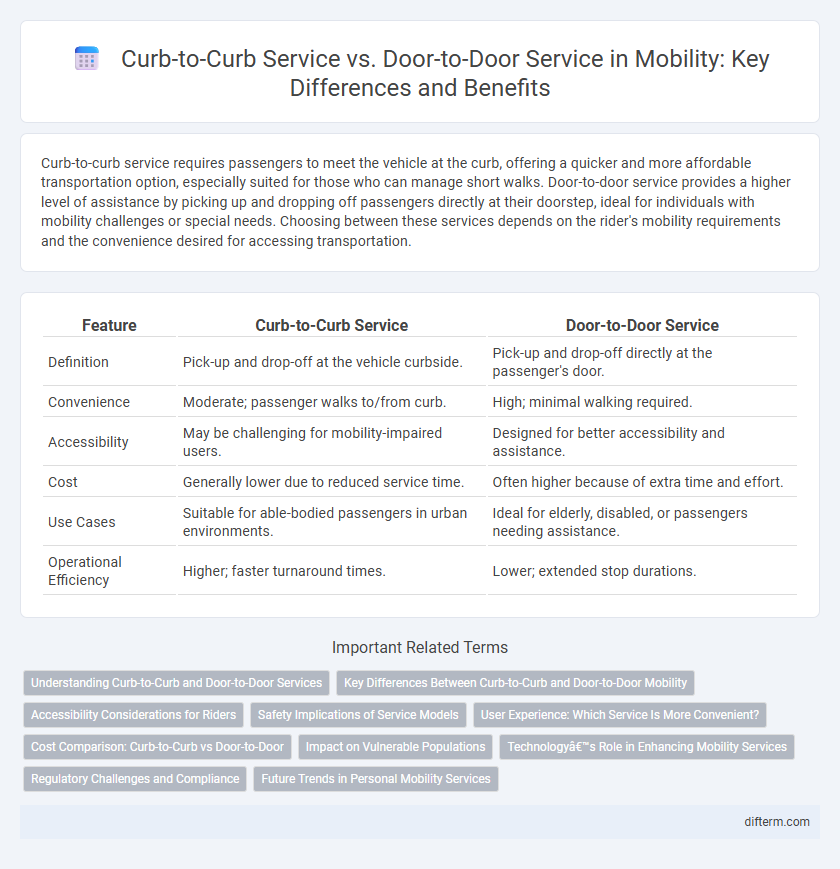Curb-to-curb service requires passengers to meet the vehicle at the curb, offering a quicker and more affordable transportation option, especially suited for those who can manage short walks. Door-to-door service provides a higher level of assistance by picking up and dropping off passengers directly at their doorstep, ideal for individuals with mobility challenges or special needs. Choosing between these services depends on the rider's mobility requirements and the convenience desired for accessing transportation.
Table of Comparison
| Feature | Curb-to-Curb Service | Door-to-Door Service |
|---|---|---|
| Definition | Pick-up and drop-off at the vehicle curbside. | Pick-up and drop-off directly at the passenger's door. |
| Convenience | Moderate; passenger walks to/from curb. | High; minimal walking required. |
| Accessibility | May be challenging for mobility-impaired users. | Designed for better accessibility and assistance. |
| Cost | Generally lower due to reduced service time. | Often higher because of extra time and effort. |
| Use Cases | Suitable for able-bodied passengers in urban environments. | Ideal for elderly, disabled, or passengers needing assistance. |
| Operational Efficiency | Higher; faster turnaround times. | Lower; extended stop durations. |
Understanding Curb-to-Curb and Door-to-Door Services
Curb-to-curb service means passengers are picked up and dropped off at the curb, requiring them to walk between their door and the vehicle. Door-to-door service involves drivers assisting passengers directly from their door to the vehicle, offering greater convenience and support. Understanding the differences helps in choosing between cost-effective curb-to-curb options and more personalized door-to-door mobility services.
Key Differences Between Curb-to-Curb and Door-to-Door Mobility
Curb-to-curb mobility service involves pick-up and drop-off at the vehicle closest to the passenger's curb, requiring users to walk between the curb and their starting or ending location, while door-to-door service offers assistance entering and exiting the actual door of a building, providing a higher level of convenience and accessibility. Door-to-door service is essential for passengers with limited mobility, such as seniors or individuals with disabilities, offering personalized help that curb-to-curb cannot. The key differences lie in the scope of assistance, making door-to-door more suitable for vulnerable populations requiring extra support throughout their journey.
Accessibility Considerations for Riders
Curb-to-curb service provides essential accessibility by ensuring vehicles stop close to pickup and drop-off points, reducing walking distance for riders with mobility challenges. Door-to-door service offers enhanced accessibility, assisting passengers from inside their residence directly to the vehicle, which benefits individuals with severe disabilities or limited independence. Both services address different levels of mobility needs, making transportation more inclusive and accommodating for diverse rider requirements.
Safety Implications of Service Models
Curb-to-curb service reduces vehicle maneuvering complexity, lowering the risk of accidents during passenger pick-up and drop-off compared to door-to-door service. Door-to-door service increases potential hazards by requiring drivers to navigate private driveways and walkways, exposing passengers and drivers to unfamiliar obstacles. Safety protocols in curb-to-curb service models emphasize designated, well-lit waiting areas, minimizing roadside risks and enhancing overall passenger security.
User Experience: Which Service Is More Convenient?
Door-to-door service offers superior user experience by providing direct pickup and drop-off at the user's exact location, reducing walking distance and effort. Curb-to-curb service requires users to navigate from their door to the curb, which can be challenging for individuals with mobility impairments, heavy luggage, or inclement weather conditions. Seamless accessibility and personalized convenience make door-to-door service the preferred choice for enhanced mobility and comfort.
Cost Comparison: Curb-to-Curb vs Door-to-Door
Curb-to-curb service typically reduces operational costs by minimizing driver time spent on navigating private properties and waiting for passengers, resulting in lower fares compared to door-to-door service. Door-to-door service demands additional labor and time, increasing expenses due to personalized pick-up and drop-off at exact locations. Cost analysis shows curb-to-curb models often offer more economical and efficient options for both providers and riders in urban mobility scenarios.
Impact on Vulnerable Populations
Door-to-door service significantly enhances mobility for vulnerable populations, including the elderly and individuals with disabilities, by providing assistance from their residence directly to their destination. This personalized approach reduces physical barriers and safety risks associated with navigating curbs, uneven terrain, and inclement weather conditions often encountered in curb-to-curb service. Research shows that door-to-door transit services improve access to essential amenities and healthcare, thereby increasing independence and quality of life for these groups.
Technology’s Role in Enhancing Mobility Services
Technology's role in enhancing mobility services has transformed curb-to-curb and door-to-door offerings by integrating real-time GPS tracking, mobile app scheduling, and advanced routing algorithms. These innovations enable precise pick-ups and drop-offs, reduce wait times, and improve accessibility for individuals with mobility challenges. Digital platforms also facilitate seamless communication between drivers and passengers, optimizing efficiency and user experience in both service models.
Regulatory Challenges and Compliance
Curb-to-curb service often faces fewer regulatory challenges compared to door-to-door service, as it typically avoids liability associated with entering private properties. Door-to-door service requires strict compliance with accessibility standards and safety regulations, including adherence to the Americans with Disabilities Act (ADA), increasing the complexity of operational permits. Regulatory agencies closely monitor door-to-door services to ensure passenger safety and legal liability, necessitating comprehensive risk management protocols.
Future Trends in Personal Mobility Services
Future trends in personal mobility emphasize seamless integration of curb-to-curb and door-to-door services through advanced AI-driven routing and autonomous vehicle technology. Innovations in real-time data analytics and sensor fusion enhance precision in pick-up and drop-off points, optimizing user convenience and operational efficiency. As urban environments evolve, adaptive mobility platforms prioritize personalized, multimodal transport solutions that reduce last-mile challenges and improve accessibility.
curb-to-curb service vs door-to-door service Infographic

 difterm.com
difterm.com